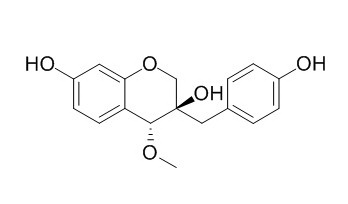3'-Deoxy-4-O-methylepisappanol
3'-Deoxy-4-O-methylepisappanol has antioxidant activity, it also exhibits significant neuroprotective activity against glutamate-induced toxicity at concentrations ranging from 0.1 microM to 10 microM.
Inquire / Order:
manager@chemfaces.com
Technical Inquiries:
service@chemfaces.com
Tel:
+86-27-84237783
Fax:
+86-27-84254680
Address:
1 Building, No. 83, CheCheng Rd., Wuhan Economic and Technological Development Zone, Wuhan, Hubei 430056, PRC
Providing storage is as stated on the product vial and the vial is kept tightly sealed, the product can be stored for up to
24 months(2-8C).
Wherever possible, you should prepare and use solutions on the same day. However, if you need to make up stock solutions in advance, we recommend that you store the solution as aliquots in tightly sealed vials at -20C. Generally, these will be useable for up to two weeks. Before use, and prior to opening the vial we recommend that you allow your product to equilibrate to room temperature for at least 1 hour.
Need more advice on solubility, usage and handling? Please email to: service@chemfaces.com
The packaging of the product may have turned upside down during transportation, resulting in the natural compounds adhering to the neck or cap of the vial. take the vial out of its packaging and gently shake to let the compounds fall to the bottom of the vial. for liquid products, centrifuge at 200-500 RPM to gather the liquid at the bottom of the vial. try to avoid loss or contamination during handling.
J Chromatogr B Analyt Technol Biomed Life Sci.2021, 1187:123012.
Molecules.2020 ,25(16):3697.
Nat Commun.2019, 10(1):2745
J Appl Biol Chem.2022, 65(4):pp.463-469.
Univerzita Karlova2022, 228192.
J Pharm Anal.2016, 6(6):363-373
Pharmaceuticals (Basel).2021, 14(10):1046.
J Ethnopharmacol.2023, 313:116534.
Oncol Rep.2021, 46(2):166.
Front Plant Sci.2022, 12:811166.
Related and Featured Products
Phytother Res. 2010 Mar;24(3):463-5.
Protective effects of 3'-deoxy-4-O-methylepisappanol from Caesalpinia sappan against glutamate-induced neurotoxicity in primary cultured rat cortical cells.[Pubmed:
19777498]
To examine the neuroprotective effects of Caesalpinia sappan L., we tested its protection against the glutamate-induced neurotoxicity in primary cortical cultured neurons.
METHODS AND RESULTS:
We found that an aqueous extract of this medicinal plant exhibited significant protection against glutamate-induced toxicity in primary cultured rat cortical cells. In order to clarify the neuroprotective mechanism(s) of this observed effect, isolation was performed to seek and identify active fractions and components. By such fractionation, two known compounds - sappanchalcone and 3'-Deoxy-4-O-methylepisappanol - were isolated from the methanol extracts from the air-dried and chipped C. sappan. Among these two compounds, 3'-Deoxy-4-O-methylepisappanol exhibited significant neuroprotective activities against glutamate-induced toxicity, exhibiting cell viability of about 50%, at concentrations ranging from 0.1 microM to 10 microM.
CONCLUSIONS:
Therefore, the neuroprotective effect of C. sappan might be due to the inhibition of glutamate-induced toxicity by the protosappanin derivative it contains.
J Enzyme Inhib Med Chem. 2010 Oct;25(5):608-14.
Antioxidant properties of benzylchroman derivatives from Caesalpinia sappan L. against oxidative stress evaluated in vitro.[Pubmed:
20105050]
METHODS AND RESULTS:
The antioxidant activity of extracts from Caesalpinia sappan L. (CSL) was studied in vitro by evaluating the total phenolics, measuring the antioxidant activity by TEAC, measuring the scavenging effects on reactive oxygen species (ROS) and on reactive nitrogen species (RNS), and measuring the inhibitory effect on Cu(2+)-induced human low-density lipoprotein (LDL) oxidation. The CSL extracts were found to have a potent scavenging activity against all of the reactive species tested, as well as an inhibitory effect on LDL oxidation, especially in the ethyl acetate (EA) fraction. Therefore, we isolated and identified benzylchroman derivatives sappanchalcone (1) and 3'-Deoxy-4-O-methylepisappanol (2) from the EA fraction of CSL and their antioxidant activities were evaluated.
CONCLUSIONS:
The studied CSL extracts and the compounds 1 and 2 were revealed to be very effective against the evaluated pro-oxidant species, including ROS and RNS.



